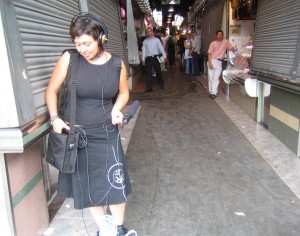Somaya Langley is a sound and new media artist whose work has been presented in significant festivals and on air throughout Australia. Somaya is currently the National Library of Australia’s Digital Preservations Officer, where her work has included the development of MusicAustralia and the Library’s online Digital Collections. Somaya recently participated in ANAT’s New Media Lab Create_Space.
 What was it that directed you towards an arts practice exploring sound and new media?
What was it that directed you towards an arts practice exploring sound and new media?
I grew up playing the French Horn. Whilst I enjoyed the submersion in music, the rigour of practice was something I did not want to pursue, and sitting up the back of an orchestra waiting for 33 bars till I was supposed to leap in with a few notes was also not that enticing! In 1994 I undertook a preparatory music course at the Canberra School of Music. Part of this course was in electroacoustic composition – six months of cutting and splicing tapes. It was at this stage that something started to intrigue me about this form of music, in particular the early tape works of Steve Reich. From there, I went on to study a Bachelor of Music, majoring in composition. My main interest was in electroacoustic music, and basically what inspired me to focus on my practice in this area was a drive to prove myself and to succeed. At the same time, I also wanted to explore computer-based music and all its possibilities.
Describe the focus of your arts practice.
During University I did not have much of an opportunity to collaborate with other artists. It has been since graduating (in 2001) that I have started a collaboration process, which assists me in pushing my artwork in new directions. It was during some time spent in Japan during 2001 for example, that I briefly met sound artist Rodney Berry, and discussed the interaction between sound and movement, its possibilities in assisting with the breakdown and reinterpretation of the formulaic links between person, computer, sound, movement etc. My fascination with body language and possible sound outcomes had existed for many years and increased when I returned to Australia and met Alistair Riddell. We began working on a project – HyperSense Complex –, which led me to explore creative outcomes utilising flex sensors. This has now translated into beginning a new exploration into using accelerometers. This is where the XYZ plane of acceleration is mapped, and this movement can be translated for example into sound, which I can then potentially “throw” around a space. I really like the way sound can work like this, and this is where my interest in the sound/performance process is currently at.
My art also incorporates sound from field recordings, as well as voice processing such as time stretching or convolution – ultimately, a transformation of the original resources. The more recent use of my voice in my performance work, I find a very empowering thing. It also acts as an extremely direct means of getting my message across to the audience. This links to a really important aspect of my practice, that is, a passion for engagement with community, and utilizing art as a means to communicate social concerns. This was particularly realised earlier in 2005, when I participated in FREEDOM Festival, an annual national music festival raising awareness for Amnesty International. This development of community and network of artists was also an important outcome of the Create_Space New Media Lab.
Your employment at the National Library of Australia focuses on digital preservation, could you briefly describe what that involves.
I am currently the Digital Preservations Officer for the National Library of Australia. The focus of my position is on preservation of digital materials (in all their many forms), developing long-term strategies for the both preservation and management of related metadata, and providing online delivery systems for out of copyright materials. Currently, the Library is examining how the newly developed Free Trade Agreement with America will affect digital content held within memory sector institutions and associated copyright laws. There are several issues that impact on the preservation of digital material, including dependencies on software and hardware, additional licensing methods such as creative commons, regional coding, and difficulty in migrating content to secure storage/preservation. It is a really important and necessary process for the longevity of creative Australian digital materials.
 How do you want to see your arts practice develop in the future?
How do you want to see your arts practice develop in the future?
In the future I want to continue the live performance angle, hopefully pushing it towards an international audience. I also want to return to my multimedia skills and re-incorporate a visual component to my work. With my position at the National Library of Australia, I think it is really important for myself to witness the preservation process. I believe this is beneficial for both myself as an individual artist, and also provides a means of contributing to the new media arts community as a whole.
Mimi Kelly
Mimi was the Marketing and Communications Officer at ANAT from 2005-2006. She is currently the Manager of Exhibitions & Gallery Development at Museums & Galleries NSW
Read More
See More
Somaya was one of the 21 participants involved in the reSkin Wearable Technology Lab – here you can see her work in action.
 This work is licensed under a Creative Commons Attribution-NonCommercial-ShareAlike 2.5 Australia.
This work is licensed under a Creative Commons Attribution-NonCommercial-ShareAlike 2.5 Australia.






